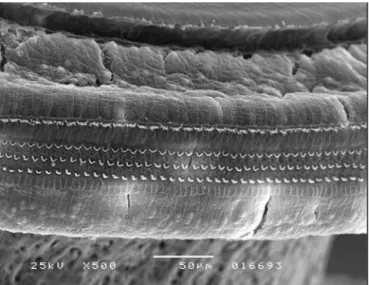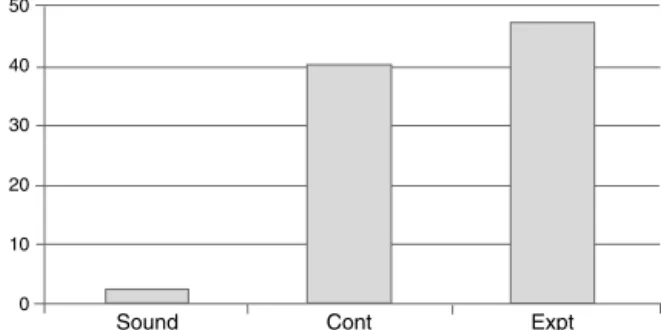Brazilian
Journal
of
OTORHINOLARYNGOLOGY
www.bjorl.org
ORIGINAL
ARTICLE
Lack
of
protection
against
gentamicin
ototoxicity
by
auditory
conditioning
with
noise
夽
,
夽夽
Alex
Strose
∗,
Miguel
Ângelo
Hyppolito,
Gleice
Cristina
Colombari,
Maria
Rossato,
Jose
Antônio
Aparecido
de
Oliveira
DepartmentofOphthalmology,Otorhinolaryngology,andHeadandNeckSurgery,HospitaldasClínicas, FaculdadedeMedicinadeRibeirãoPreto,UniversidadedeSãoPaulo(USP),RibeirãoPreto,SP,Brazil
Received5December2013;accepted5June2014 Availableonline22July2014
KEYWORDS Innerear;
Sensorineuralhearing loss;
Deafness; Noise;
Acousticstimulation; Toxicity
Abstract
Introduction:Auditoryconditioningconsistsofthepre-exposuretolowlevelsofapotential harmfulagenttoprotectagainstasubsequentharmfulexposure.
Objective:Toconfirmifconditioningwithanagentdifferentfromthatusedtocausethetrauma canalsobeeffective.
Methods:This was an experimental study with 17 guinea pigs, divided into three groups: an ototoxic controlgroup (Cont)that received intramuscular administrationof gentamicin 160mg/kg/dayfortenconsecutivedays,butnosoundexposure;asoundcontrolgroup(Sound) thatwasexposedto85dBbroadbandnoise centeredat4kHz, 30mineachdayforten con-secutivedays,butreceivednoototoxicmedications;andanexperimentalgroup(Expt)that received sound exposure identical to the Sound group and after each noise presentation, receivedgentamicinsimilarlytoContgroup.Theanimalswereevaluatedbydistortionproduct otoacousticemissions(DPOAEs),brainstemauditoryevokedpotentials(BAEPs),andscanning electronmicroscopy.
Results:Theanimalsthatwereconditionedwithnoisedidnotshowanyprotectiveeffect com-paredwiththeonesthatreceivedonlytheototoxicgentamicinadministration.Thislackof protectionwasobservedfunctionallyandmorphologically.
Conclusion:Conditioningwith85dBbroadbandnoises,30minadayfortenconsecutivedays doesnotprotectagainstanototoxicgentamicinadministrationof160mg/kg/dayforten con-secutivedaysintheguineapig.
© 2014Associac¸ãoBrasileira de Otorrinolaringologiae CirurgiaCérvico-Facial. Publishedby ElsevierEditoraLtda.Allrightsreserved.
夽 Pleasecitethisarticleas:StroseA,HyppolitoMÂ,Colombari GC,RossatoM,deOliveiraJA.Lackofprotectionagainstgentamicin ototoxicitybyauditoryconditioningwithnoise.BrazJOtorhinolaryngol.2014;80:390---6.
夽夽
Institution:Department ofOphthalmology, Otorhinolaryngology,and Head and NeckSurgery, Hospital dasClínicas, Faculdade de MedicinadeRibeirãoPreto,UniversidadedeSãoPaulo(USP),SP,Brazil.
∗Correspondingauthor.
E-mail:alexstrose@yahoo.com.br(A.Strose).
http://dx.doi.org/10.1016/j.bjorl.2014.07.009
PALAVRAS-CHAVE Orelhainterna; Perdaauditiva neurossensorial; Surdez;
Ruído;
Estimulac¸ãoacústica; Toxicidade
Faltadeprotec¸ãocontraaototoxicidadedagentamicinapelocondicionamento auditivocomruído
Resumo
Introduc¸ão: Ocondicionamento auditivoconsiste dapré-exposic¸ão deum agente lesivo em baixosníveisparaprotegercontraumaposteriorapresentac¸ãolesiva.
Objetivo: Confirmarseocondicionamentocomumagentediferentedoutilizadoparacausaro traumapodeserefetivo.
Método: Estudoexperimental com17 cobaiasalbinas divididas como aseguir- grupoSom: expostoaumruídobrancode85dBcentradoem4kHz,30minutospordiapor10dias consecu-tivos;grupoControle(Cont):administrac¸ãointramusculardegentamicina160mg/kgpordiapor 10diasconsecutivos;grupoExperimental(Expt):condicionadocomruídocomoogrupoSom. Apóscadaexposic¸ãoaoruído,recebeugentamicinasimilarmenteaogrupoCont.Osanimais foramavaliadosporemissõesotoacústicas-produtodedistorc¸ão(EOAPDs),potencialevocado auditivodetroncoencefálico(PEATE)emicroscopiaeletrônicadevarredura(MEV).
Resultados: Osanimais queforam condicionadoscom ruído não mostraramqualquer efeito protetor,em comparac¸ãocomosquereceberamapenas agentamicinaemdosesototóxicas. Estaausênciadeprotec¸ãofoiobservadatantofuncionalmentequantomorfologicamente.
Conclusão:Osautoresconcluemqueocondicionamentocomruídobrancoa85dBpor30 min-utospordiapor10 diasconsecutivosnãoprotegecontraumaadministrac¸ãodegentamicina 160mg/kg/diapor10diasconsecutivos.
©2014Associac¸ãoBrasileiradeOtorrinolaringologiaeCirurgiaCérvico-Facial.Publicado por ElsevierEditoraLtda.Todososdireitosreservados.
Introduction
Auditoryconditioningconsistsofapre-exposureofa poten-tially harmful agent to the auditory system at low or non-toxic doses to stimulate intrinsic mechanisms that increasetheresistanceoftheauditorystructures,thus pro-tecting them against a subsequent exposure tothe same agentusedinpre-exposure,oragainstotheragents poten-tiallyharmfultotheorganofCorti.The agentfirsttested wasnoise,1,2usedbothforconditioningaswellastocause
auditory trauma. Since then, this phenomenon has been testedindifferentanimals,suchasguineapigs,chinchillas, Mongolian gerbils, and even in humans. The results have shownareductioninmorphologicandfunctionaldamagein conditionedanimals,comparedwiththoseexposedonlyto traumatic stimuli.1,3---5 Manyconditioning paradigms, using
differentfrequencies, intensities, andpatternsof presen-tation,suchascontinuousor intermittentexposures,have proventobeeffective.1,3---6Conditioningwithagentsother
thannoisehasalsobeenshowntobeeffective.Pre-exposure tolowdosesofamikacinhasbeenshowntobeeffectivein protectingagainst subsequent administrationof the same drug in harmful doses.7 The same effectwas shown with
gentamicin.8It hasbeen suggested thatthe stresscaused
byconditioning,andnottheactionofaparticularagent,is responsibleforstimulating protectivemechanisms.9These
researchershypothesizedthatthisstresscanstimulatethe release of corticosteroids, known to attenuate cochlear damage.
However, the vast majority of studies use the same agentfor conditioningandcausing trauma.More recently, the effectiveness of conditioning with a different agent fromthatusedtocausetraumawastested.Theneshkumar
etal. exposedrats toan 8kHz noisewith an intensity of 85dBfor15min,inordertoreducethedamagecausedby cisplatin.10Theirstudydemonstratedthatanimalsthatwere
noise-conditioned showeda smaller change in their hear-ingthresholds, compared tothose that receivedonly the drug.Anotherstudyconditionedmicewithkanamycinand thenexposedtheanimalstoabroadbandnoise(4---45kHz) at 110dB intensity for 30s.11 The animals that received
thedrugbeforethenoiseexhibitedlesscochleardamage, demonstratedbymorphologicalandfunctionalassessments conductedduringthestudy.Athirdstudyconditionedguinea pigsby administering ototoxicdoses of gentamicin, in an attempt to protect them against a subsequent acoustic trauma.Animalsconditionedwithgentamicinexhibitedless cochlear damage than those who were treated only with acoustic trauma.12 Yet another study conditioned
Mongo-liangerbilswithnoise,inanattempttoprotecttheanimals againstatopicaladministrationofgentamicinappliedacross theroundwindow. Theauthors usedaconditioning proto-colconsistingofacontinuousnoisewithfrequencybetween 1410Hzand5650Hzat81dBfor3weeks,andobservedthat thegrouptreatedwiththisstimulusshowedfewerinjuries tothe inner and outer hair cells.13 Another study tested
whetherconditioningmicewithanoiseabletocausea tem-poraryshiftinthethresholdwouldbeeffectiveinprotecting theanimalsagainstgentamicinandcisplatinototoxicity.The researchers observed that the presentation of a noise of 8---16kHzatanintensityof91dBfor2hcausedatemporary thresholdshiftandalsoprotectedagainsttheototoxicityof thesesubstances.14Thepurposeofthepresentstudywasto
Materials
and
methods
Thiswasanexperimentalstudyinwhichatotalof17albino guineapigswereused;theyweighedbetween350and500g andhadnomiddleearinfection,asdeterminedbyotoscopy. Thesamplesizeanditsdistributionwerestatisticallyscaled, inordertomeettherequirementsoftheEthicsCommittee, aimingattheuseofthelowestpossiblenumberofanimals. AllprocedureswereapprovedbytheEthicsCommitteeon Animal Experimentation of the institution (Document No. 058/2008).The animalswere selectedbypresence ofthe Preyer reflex.Only animals with distortion product otoa-cousticemissions(DPOAEs)andelectrophysiologicalhearing thresholdsof25dBestimatedbybrainstemauditoryevoked potential(BAEP)wereincludedinthestudy.
The animals were divided into three groups: the first group (Cont) acted as control for gentamicin lesion and consisted of five animals that received intramuscular gentamicininanototoxicdose,160mg/kg/dayforten con-secutivedays.Thesecondgroup(Sound)actedascontrolfor noiseconditioningandconsistingofsixanimalstreatedwith noisecenteredat4kHzatanintensityof85dBduring30min perdayfortenconsecutivedays.Thisfrequencywaschosen becausethefunctionalmethodsofassessmentusedinthis studyareeffectivefordetectingchangesinthisfrequency band;and,inaddition,totestifconditioningwiththis fre-quencywouldalsobeeffective.Thethirdgroup(Expt),the experimental group, consisted of six animals which were conditionedinthesamewayastheSoundgroup;however, after30minofnoiseexposure,theanimalsreceiveda poten-tiallyharmfulgentamicindoseof160mg/kg/dayfor10days, inthesamewayastheContgroup.Theinjuryprotocolby gentamicin,asmentionedabove,hadbeensuccessfullyused inpreviousstudies.8
Functionalassessment
The functionalassessment wasperformed by examination of distortion product otoacoustic emissions (DPOAEs) and brainstemauditoryevokedpotential(BAEP).Theequipment usedwasthe SMARTDPOEA/EP andSMART EP(Intelligent HearingSystems-Miami,Florida,UnitedStates).
Toperformthetests,theanimalswereanesthetizedwith intramuscular ketamine at a dose of 65mg/kg; this is an anestheticdrugwithoutsignificanteffectsonthe function-ingoftheauditorysystem.15
BAEPandDPOAE
Functionalassessment by BAEP and DPOAEtests was per-formedatthefollowingtimepoints:beforeanytreatment inall animals;onehour afternoise conditioningtoassess whetherthisprocedurewasharmlesstotheauditorysystem; and1 day after administrationof thelast dose of genta-micin,bothinthegrouptreatedonlywiththismedication (Cont),andinthegroupwithnoiseconditioningbeforethe administrationofgentamicin(Expt).
Forevaluationofauditoryelectrophysiologicalpotentials (BAEP),surface electrodeswere positionedonthecranial vertex(positive)andtheposteriorportionofthepinna bilat-erally(negative),andareferenceelectrodewasplacedon
theforehead(ground).Theresponseoftheauditory poten-tialswasobtainedfromtheaverageof2048stimuliforeach intensity.Aclick-typestimuluswasused,presentedata rep-etitionrateof11.1/s.Hearingthresholdwasdefinedasthe lowestintensityatwhichitwaspossibletoidentifyawave IIintworecords.
DPOAEs were performed according tothe 2F1-F2 rela-tion, with respect to an F1:F2 ratio=1.22. The intensity of both frequencies was70dB. Responses froma low fre-quencyof1---4kHzwereevaluated.Thepresenceorabsence of responseaccordingtothesignal/noiseratiowas deter-mined. In addition,the values obtained before and after eachtreatmentforeachgroupwerestatisticallyanalyzed.
Morphologicalassessment
Scanningelectronmicroscopy(SEM)
Allguineapigswereeuthanizedatthescheduledtime,one hourafterthelastfunctionalassessment,after intramuscu-laranesthesiawithketaminehydrochloride(65mg/kg)and xylazine (6.5mg/kg). The animals were then decapitated andtheircochleaewereremovedfromthebulla.
Forfixation,asolutionof3%glutaraldehydein0.1M phos-phatebuffer,pH7.4,for 4h at4◦C,wasinjectedthrough
the roundwindow. The cochleaewere rinsedthree times for5minwiththesamebuffer,thenfixed with1%osmium tetroxide for 2h at 4◦C and subjected to dehydration at
room temperaturein a batteryof increasing ethanol con-centrations (50%, 70%, 90% and 95%, 1×/10min for each
concentration) and in absolute ethanol 3×/15min. When
thedehydrationwasover,thedryingphasewascompleted usingthecriticalpointmethodinCO2,inwhichthe mate-rialisdevoidofwater.Afterbeingfixedonanappropriate specimenplate,thematerialwascoatedwithgoldvapour depositioninavacuumcameraandexaminedwitha scan-ningelectronmicroscope.
ForanalysisandphotographyofSEMspecimens,an elec-tron microscope JEOL SCANNING MICROSCOPE - JSM 5200 wasused.
For the statistical analysis, an injured hair cell was definedasacellexhibitingtotalabsenceofcilia;anyother change inthesestructureswasnottakenintoaccountfor statistical calculation. Only lesionstotheouter hair cells wereconsidered.Thecochleaoftheguineapigisformedby three-and-a-halfturns,i.e.thefirst,secondandthirdturns, andanapicalportionformedbyahalfturn.Eachturnmay bedividedintothreethirds,i.e.thefirst,middle,andfinal third.Thepercentageofdamagedouterhaircellsfromthe totalnumberofhaircellswascalculatedforthemiddlethird of each turn, except the apical portion. This calculation was obtained from a cochleogram. The cochleogram was definedasthegraphicalrepresentationofaSEMphotograph ofthemiddlethirdofthefirst,second,andthirdcochlear turnsinafieldof500×magnification.Theapicalregionwas
Table1 ValuesofDPOAEpre-conditioningwithnoiseand post-exposure to an ototoxic dose of gentamicin --- Expt group.
Exptgroup F1 F1.5 F2 F3 F4
Pre- 24.08 25.33 20.33 18a 26.33a
Post- 8.75 9.17 12.58 3.5a 12.92a
a Statisticallysignificantdifference.
Noiseconditioning
The guineapigswereconditioned withawhitenoise cen-teredat 4kHz,at anintensityof85dB,30minperdayfor 10consecutivedays.Theexposurewasperformedwiththe animalsinsideasoundproofbox (EP-125AudioSignal Gen-erator;Insight---RibeirãoPreto,SP,Brazil).Thedimensions ofthedevicewere760mm×485mm×705mm.Inside the
box, the animals wereplaced in a cage withthreeequal divisions,withthreeguineapigsatatime.Theanimalshad freeaccesstofoodandwaterandwerekeptina12hour light-darkcycle.Soundamplifierswereattachedtothetop ofthebox,atadistanceof25cmfromthetopofthecage. The variationof noise intensity was less than2dBat any pointinsidethebox.
Statisticalanalysis
Statistical analyses were performed using nonparametric Mann---Whitney U and Wilcoxon tests. A significance level of5%(p=0.05)wasadopted.Theanalyseswereperformed withSPSS,Minitab,andExcelprograms.
Results
DPOAEresults revealedthat theContgroupthat received only gentamicin in ototoxic doses, and the Expt group that wasnoise conditioned prior tothe administrationof the aminoglycoside, exhibited no response at any of the test frequencies in the assessments performed after drug administration. Evaluating these results in more detail, it was also observed that, both groups (Cont and Expt), had no responses after the administration of gentamicin and, in addition, the group that was noise conditioned priortothismedication(Exptgroup)exhibitedsignificantly worse valuesat frequenciesof 3kHz and4kHz versus the grouptreated onlywiththeaminoglycoside(p=0.009 and
p=0.007,respectively)(Table1),suggestingapotentiation of the deleteriouseffects of the drugby pre-exposure to noise.TheSoundgroup,treatedonlywithnoise condition-ing,exhibitedintriguingresults. Responseswereobserved in post-noiseDPOAEsin all frequenciesof thisgroup and, additionally,therewasimprovementinpost-treatment val-uesofDPOAEs,comparedtopre-treatmentbaselinevalues. Thisimprovementwasobservedatallfrequencies,butthe differencewassignificant onlyatthe frequenciesof1kHz (p=0.006)and4kHz(p=0.023)(Table 2).Withrespectto electrophysiologicalhearingthresholdsobtainedbyBAEP,it wasobserved thatonlythenoise-conditionedSoundgroup animalsshowednoworseningoftheirthresholdsafterthe respective treatment (noise conditioning). Their pre- and post-thresholdswere17.9dBand15.8dB,respectively.The
Table2 ValuesofDPOAEpre-andpost-exposureto condi-tioningnoise---Soundgroup.
Soundgroup F1 F1.5 F2 F3 F4
Pre- 23.58a 26.08 20.17 23.58 25.08a
Post- 36.33a 35.58 24.67 24.17 37.75a
a Statisticallysignificantdifference.
60
50
40
30
20
10
0
Sound
Pre Post
Cont Expt
Figure1 Hearingthresholds(indB)beforeandafter respec-tivetreatmentsforSound,Cont,andExptgroups.
ContandExptgroupsexhibitedsimilardeteriorationintheir hearingthresholdsinpre-andpost-comparisons.The hear-ingthresholdsof theanimals ofthese groupshad amean value,beforeanytreatment,of8.5dBand13.7dB, respec-tively.TheContandExptgroupsshowedsimilarworsening oftheirhearingthresholdsinthepre-andpost-comparison. Beforeanytreatment,thehearingthresholdsoftheanimals ofthesegroups hadaverage valuesof 8.5dB and13.7dB, respectively. After administration of the aminoglycoside, thethresholdsofContandExptgroupsbecame,onaverage, 53.5dBand52dBrespectively,withnostatistically signifi-cantdifference(Fig.1).
ThehistologicalevaluationrevealedthattheSoundgroup hadnotbeendamagedasaresultoftheauditory condition-ingwith a white noise of 4kHz at the intensity of 85dB, 30minperdayfortenconsecutivedays(Fig.2).The histo-logicalanalysisandthecochleogramsshowedthefollowing
50
40
30
20
10
0
Sound Cont Expt
Figure3 Percentageofouterhaircelldamageineachgroup aftertheirrespectivetreatments.
Figure 4 Photo from Cont group (scanning electronic microscopy),500×magnification.
mean percentage of injury for each group: Sound: 2.2%; Cont:39.9%;andExpt:47.3%(Figs.3---5).Bydetailingthese resultsandevaluatingthemeanpercentageofdamageper each turn, it was perceived that the Cont group, which receivedonlygentamicininototoxicdoses,andExptgroup, whichwasnoise-conditionedpriortotheadministrationof
Figure 5 Photo from Expt group (scanning electron microscopy),500×magnification.
thisdrug,showedsimilarvaluesforinjuryinfirstandsecond cochlearturns---Cont(firstturn):52.7%andExpt(firstturn): 53.2%;andCont(secondturn):32.8%andExpt(secondturn): 36.9%.However,whencomparingthemeanvaluesforouter haircells damagebetweenthesetwogroups,itwasfound thattheExptgrouphadagreaternumberoflesions, com-paredwiththeContgroup:47.3%and39.9%,respectively. However,thisdifferencewasnotstatisticallysignificant.
Discussion
The vast majority of studies testing auditory conditioning have demonstratedgood results.Many typesof noise and drugshavebeentestedsuccessfully.Almostallofthese stud-iesusedthesamestimulusintheconditioningandtraumatic phases.Thefirststudyevidencingthisphenomenon condi-tionedguineapigswithnoise,withtheaimofstimulatingthe bodytodevelopprotectionmechanisms,notyetfully under-stood, against a subsequent presentation of an acoustic trauma.1Severalothersubsequentstudiesalsousednoise,
bothasaprotectiveagentandasatraumaticfactor,allof themwithpositiveresults.1---6Anotherverycommoncauseof
hearinglossisinducedototoxicitybyaminoglycosidedrugs. Basedonthesameprincipleofauditorynoiseconditioning, otherstudiestestedwhetherpre-exposuretonon-traumatic dosesofaminoglycosides alsoavoid oratleastreduce the damagecausedbyanototoxicadministrationofthesedrugs. Theresultsshowedthatconditioningwasalsoeffectivewith drugs.7,8 The injury protocol for gentamicin used in this
studywasthesameastheaforementionedwork.8
Further-more, the use of different drugs in the conditioning and traumaphase,e.g.,conditioningwithsalicylatefor protec-tionagainstcisplatinorgentamicin,wastested.16,17 These
studiesalsoshowedpositiveresults.Onlyonestudyshowed no protection by cross-conditioning with different drugs. Non-ototoxic doses of gentamicin were administered for protection against further ototoxicity withamikacin. The resultsshowedthattheanimalspreviouslytreatedwith gen-tamicin (i.e.,conditioned) showednosignsof protection, comparedwiththosetreatedonlywithamikacin.18
Ithasbeensuggestedthatthestressresultingfromthe auditoryconditioningprocedure,ratherthantheaction of anyagentinparticular,promotestheobservedprotection. Thiscouldoccurbythereleaseofcorticosteroidsinresponse to stress.9 This hypothesis was recently challenged by a
studythattestedwhetherconditioningwithkanamycinwas effective in protectingagainstacoustic trauma.To deter-mineiftheconditioning processitselfwasresponsiblefor stimulatingprotectivemechanisms,oneofthestudygroups receivedsalinesolution(ratherthankanamycin),usingthe sameschemeofadministrationasthoseanimalsthatwere conditionedwithkanamycin.Bothgroups wereexposedto acoustictrauma.Theanimalsthatreceivedsalinesolution showednoprotectiveeffect,whichledtheauthorsto con-cludethattheprotectionresultingfromthestressofanimal handlingandfromtheinjectionswasnotsignificant.11
at 8kHz at an intensity of 85dB for 15min. After45min, cisplatin was administered intravenously at a single dose of 14mg/kg. The evaluation was made by determining the electrophysiological thresholds by BAEP before and after administration of cisplatin. The researchers found thatnoise-conditionedanimalsshowedasignificantlylower change intheir auditorythreshold thanin thosereceiving cisplatinalone.10 Inanotherstudy,whichdidnothave the
studyofauditoryconditioningasitsprimaryobjective,but ratherstudiedthesynergybetweenamikacinandnoiseina populationofyoungCBA/Jmice,theauthorswereledtothe ‘‘startlingconclusion’’thatadministrationoftheantibiotic beforetheacoustictraumanotonlydidnotcause potenti-ationofthedamagecausedbythedrug,butalsoprotected the outer hair cells,which, in animalsreceiving amikacin priortoacoustictrauma,showedlessexpressiveinjury.11
Anotherstudytestedtheconditioningwithgentamicinin nontraumaticdosesforprotectionagainstacoustictrauma. Theauthorsusedalbinoguineapigsmedicatedwith intra-musculargentamicin30mg/kg/dayfor30consecutivedays andsubsequentlyexposedtoacontinuousacoustictrauma centered on 4kHz at an intensity of 110dB for 72h. It was found that the animals conditioned with gentamicin showed less morphological damage, assessed by scanning electronmicroscopy.However,nofunctionalprotectionwas observed, since the change in thresholds was similar in both conditioned andunconditioned animals.12 A
continu-ous noise conditioning with a frequency between 1410Hz and 5650Hz at 81dB for 3 weeks was used in another study totest whether thisprocedure would promote pro-tection against a topical administration of intratympanic gentamicin.14The researchersfoundthattheanimals
con-ditionedwiththisstimulushadlessinjurytotheirinnerand outer hair cells. Nofunctional assessments weremade. A conditioning protocol with the use of a traumatic noise, leading to a temporary decrease of the thresholds, was alsotestedforprotectionagainstcisplatinandgentamicin ototoxicity.Thisconditioningwaseffectiveagainstthetwo drugs,bothmorphologicallyandfunctionally.13
In the present study, the noise-conditioned animals showed no protection compared with animals that were treated with ototoxic doses of gentamicin. This lack of protectioncouldbeobservedbothfunctionallyand morpho-logically.Thenoise-conditionedanimalsshowedabsenceof DPOAE,changeinelectrophysiologicalthresholds,andouter hair cell damage similartothat observed in animals that receivedonlythedrug.Therewerenootherstudiesfound withthesamemanner of conditioningprotocol asusedin this work.Most studiestesting auditory conditioning used noises for longer periods than those used in the present work.Insome,thenoiseconditioning wasperformed con-secutivelyfordays.14Thechoiceofaconditioningprotocol
withuseofnoiseforashorterperiodwasbasedonan above-mentionedstudythatshowedgoodresultsagainstcisplatin ototoxicity.10However,itwasdecidedtotestwithaslightly
longerprotocolthanthatusedintheaforementionedwork (i.e.onlyonepresentationofnoisefor15min).
Other studies have already achieved positive results with noise conditioning as a prevention against cisplatin ototoxicity.10,14 One of them performed the conditioning
withwhitenoisecenteredat8kHzatanintensityof85dB for 15min, to protect against a single dose of cisplatin
14mg/kg. The other study used a protocol of noise at 8---16kHz,91dBfor2h,whichcausedatemporarythreshold shift;thislatterstudy alsoobservedprotectionofanimals thusnoiseconditionedagainstbothcisplatinandgentamicin ototoxicity.Thisprotocol of ototoxicinjurywith gentami-cin was the same used in previous works, consisting of 160mg/kg/day for ten consecutive days.8 In the present
study,thepresentationoftheconditioningnoisewasmade overaperiodof30minbeforeeachdoseoftheantibiotic. Thehypothesis for theabsenceofprotection triggeredby thisconditioningprotocolis thatitwasnotstrong enough totriggertheintrinsicmechanismsresponsibleforthe pro-tection; or at least not strong enough to protectagainst injuryof the magnitudecaused by 160mg/kg/dayfor ten consecutivedays.Onehypothesisforthemechanism respon-siblefortheeffectivenessofnoiseconditioningisthatthe stress triggered by stimulation results in release of heat shockprotein.14Therefore,itseemsimportantthatthe
con-ditioningstimulusbeabletogeneratesomekind ofstress incochlearstructures.Previousstudieshaveshownthatthis doseofgentamicinpromotesextensivedamagetoouterhair cells.8Knowingthataconditioningprotocolhadbeen
effec-tivewithapre-exposure ofwhitenoise centeredat 8kHz at an intensity of 85dB for only 15min, asin the above-mentioned study,the authors intended to test whether a conditioningprotocol usingashortexposureperiodwould also be effective. It would be very worthwhile to define simplerandlesstraumaticpossibleconditioningprotocols, whenconsideringpossiblefutureclinicalapplicationsofthis paradigm.It is also important tounderscoresome differ-encesbetweenthestudymentionedabove,whichachieved positiveresultswithnoiseconditioningfor15min,andthe presentstudy.Theanimalstudiedbytheseauthorswas dif-ferentand,inaddition,theototoxicitywasachievedwitha singledoseofcisplatin.Anotherimportantpointisthatthe assessment performed by them wasonly functional, esti-matingtheelectrophysiologicalthresholds,andstudieshave been publishedthat showdisagreement betweenauditive thresholdsandmorphologicalchanges.19TheDPOAEfindings
revealthatthepresentstudy’sconditioningseemstohave stimulatedouterhaircells(OHC),sincethevaluesobtained bythispost-noiseexposureexamination,intheSoundgroup, showedanimprovedresponse,andthisresponsewas statis-ticallysignificantforfrequencies1and4kHz,asshowninthe presentresults.Thus,anoiseconditioningprotocolat85dB for30minfortenconsecutivedaysseemstohavestimulated theouterhaircells,butnotenoughtoprotectthemagainst ototoxicinjury; or perhaps thischange was justa sign of earlyinjurytocochlearstructures.Inviewoftheauthors’ personal experienceand also considering the information obtainedbyotherstudies,itisbelievedthatthe condition-ingprotocolshouldnothaveanintensitysodetrimentalas tocausegreatcochleardamage,norsobenignastonot pro-moteanychangeincochlearstructures-whichappearsto haveoccurredinthepresentconditioningprotocol.
betweennoiseandgentamicin,consideringthattheanimals receivingbothfactorshadworseoutcomesthanthosewho receivedeachfactoralone.However,consideringtheresults obtainedbythisstudy,itcannotbestatedthattherewas aneffectivesynergismbetweenthesefactors.Asmentioned above,thoseanimalstreatedonlywithnoiseexhibited vir-tuallynoinjury.Conversely,theanimalsofExptgroup,that receivedgentamicinafternoise,exhibitedgreaterchanges thanthosetreatedonlywithgentamicin.Functionally,the variationinauditorythresholdswasverysimilar,withno sta-tisticallysignificantdifference.However,theDPOAEresults showed, at frequencies of 3 and 4kHz, that the animals treated with both factors showed statistically significant worseresults,comparedtoanimalstreatedonlywith genta-micin.Histologically,theanimalsofExptgroup,whichwere treated with both factors, also had a greater number of outer hair cells injuries; however this differencewasnot statisticallysignificant.
Conclusion
Thepresentstudydemonstratedthattheconditioning pro-tocolwithawhite noisecenteredat 4kHzat an intensity of 85dB for 30min per day for ten consecutive days was not effective in preventing cochlear damage caused by intramuscular administration of gentamicin in a dose of 160mg/kg/dayfortenconsecutivedays.
Conflicts
of
interest
Theauthorsdeclarenoconflictsofinterest.
References
1.Canlon B, Borg E, Flock A. Protection against noise trauma bypre-exposure toa low level acoustic stimulus.Hear Res. 1988;34:197---200.
2.CanlonB,FrassonA.Morphologicalandfunctionalpreservation oftheouterhaircellsfromnoisetraumabysoundconditioning. HearRes.1995;84:112---24.
3.Campo P,SubramaniamM, HendersonD.The effectof ‘con-ditioning’exposuresonhearinglossfromtraumaticexposure. HearRes.1991;55:195---200.
4.RyanAF,BennettTM,Woolf NK,AxelssonA.Protection from noise-induced hearing loss by prior exposure to a nontrau-matic stimulus: role of the middle ear muscles. Hear Res. 1994;72:23---8.
5.MiyakitaT,HellströmP,FrimansonE,AxelssonA.Effectoflow levelacousticstimulationontemporarythresholdshiftinYoung humans.HearRes.1992;60:149---55.
6.WhiteDR,BoettcherFA,MilesLR,GranttonMA.Effectiveness ofintermittentandcontinuousacousticstimulationin preven-tingnoise-inducedhearingandhaircellloss.JAcoustSocAm. 1997;103:1566---72.
7.OliveiraJAA,CanedoDM,RossatoM.Otoprotectionofauditory hair cells against amikacin ototoxicity. Rev Bras Otorrino-laringol.2002;68:7---13.
8.Maudonnet EN, Oliveira JAA, Rossato M, Hyppolito MA. Gentamicinattenuatesgentamicin-inducedototoxicity--- self-protection.DrugChemToxicol.2008;31:11---25.
9.Wang Y, HiroseK, Liberman MC. Dynamics of noise-induced cellular injuryand repair inthemouse cochlea.J AssocRes Otolaryngol.2002;3:248---68.
10.TheneshkumarS,LoritoG,GiordanoP,PetruccelliJ,MartiniA, HatzopoulosS.Effectofnoiseconditioningoncisplatin-induced ototoxicity:apilotstudy.MedSciMonit.2009;15:173---7.
11.FernandezEA,OhlemillerKK,GagnonPM,ClarkWW.Protection againstnoise-inducedhearinglossinyoungCBA/Jmiceby low-dosekanamycin.JARO.2010;11:235---44.
12.Strose A, Colombari GC, Rossato M, Hyppolito MA, Oliveira JAA. Gentamicin conditioning confers auditory protection against noise trauma. Eur Arch Otorhinolaryngol. 2013,
http://dx.doi.org/10.1007/s00405-013-2707-6.
13.RoyS,RyalsMM,VandenBrueleAB,FitzgeraldTS,Cunningham LL.Soundpreconditioningtherapyinhibitsototoxichearingloos inmice.JClinInvest.2013;123:4945---9.
14.SuryadevaraAC,WanamakerHH,PackA.Theeffectsofsound conditioningongentamicin-inducedvestibulocochleartoxicity ingerbiils.Laryngoscope.2009;119:1166---70.
15.Smith DI, Mills JH. Anesthesia effects: auditory brain-stem response. Electroencephalogr Clin Neurophysiol. 1989;72:422---8.
16.ShaSH,SchachtJ. Salicylateattenuatesgentamicin induced ototoxicity.LabInvest.1999;79:807---13.
17.HyppolitoMA,OliveiraJAA,RossatoM.Cisplatinototoxicityand otoprotectonwithsodiumsalicylate.EurArchOtorhinolaryngol. 2006;263:798---803.
18.AquinoTJM[Tesededoutorado]Ototoxicidadeeotoprotec¸ão em orelha internade cobaiasutilizando gentamicina e ami-cacina:aspectosultraestruturaisefuncionais.RibeirãoPreto: UniversidadedeSãoPaulo;2007.
19.ChenYS,LiuTC,ChengCH,YehTH,LeeSY,HsuCJ.Changes ofhaircellstereociliaandthresholdshiftafteracoustictrauma inguineapigs:comparisonbetweeninnerandouterhaircells. ORL.2003;65:266---74.

